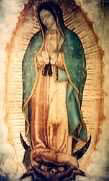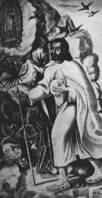 The Apparitions at Tepeyac in Mexico: Our Lady of Guadalupe
The Apparitions at Tepeyac in Mexico: Our Lady of Guadalupe
Juan Diego, the seer of Guadalupe, was a recently baptised adult convert, aged 57, when Mary appeared to him in 1531 at Tepeyac hill, near Mexico city, formerly the site of a pagan temple. He was a widower, his wife having died in 1529. On his way to Mass on 9 December, the feast of the Immaculate Conception at the time, he saw an apparition of a beautiful young girl surrounded by light. She told him of her love for the people of Mexico, and asked that the local Bishop, Juan de Zumárraga, build a temple or church on that spot. Juan Diego presented himself before the Bishop and explained Mary’s request. But the result was that he was initially rebuffed by the perplexed bishop, who said he would really need a sign from heaven in order to comply. On her next meeting with Juan Diego, however, the Lady promised a sign that would convince the bishop, but when he returned to his village he found that his uncle, who he lived with, was seriously ill, in fact dying, and in need of the last sacraments. He met Mary again on his way back to Mexico city to fetch a priest, and she told him that he was free to visit the Bishop, because even now his uncle was well again.
Juan Diego presented himself before the Bishop and explained Mary’s request. But the result was that he was initially rebuffed by the perplexed bishop, who said he would really need a sign from heaven in order to comply. On her next meeting with Juan Diego, however, the Lady promised a sign that would convince the bishop, but when he returned to his village he found that his uncle, who he lived with, was seriously ill, in fact dying, and in need of the last sacraments. He met Mary again on his way back to Mexico city to fetch a priest, and she told him that he was free to visit the Bishop, because even now his uncle was well again.
Mary then asked Juan Diego to gather some miraculous, out-of-season, flowers, which he would find at the top of the hill and carry them in his rough cactus fibre outer garment, his tilma, to the Bishop. She strictly ordered him not to show the contents of the tilma to anyone on the way. Once there he began to tell his story while unfolding the tilma, as the Bishop, and some important guests who happened to be present, saw the wonderful Image of Our Lady of Guadalupe on it. This, rather than the flowers, was the real sign for Bishop Zumárraga.
News of the prodigy spread quickly and the result was that the Aztecs, who had been reluctant to get involved in Christianity, as the religion of their conquerors, the Spanish, flocked into the Church. The title “Guadalupe” is probably the phonetic equivalent of the title, “She who breaks, stamps or crushes the serpent,” a perfect image of the way devotion to Mary was able to destroy the vestiges of the satanically inspired Aztec religion which involved human sacrifice. Snake symbolism was very prevalent in this religion.
The miraculous Image has been preserved in Mexico now for over four and half centuries, although such fibre garments usually disintegrate within twenty years. It has defied all attempts to give it a natural explanation and thus we can have full confidence in the historicity of accounts of Our Lady of Guadalupe.
Sources: A Handbook on Guadalupe, New Bedford, 1997; Johnston, The Wonder of Guadalupe, Devon, 1981; Carroll, Our Lady of Guadalupe and the Conquest of Darkness, Front Royal, 1983.
Mary’s words at Guadalupe
Recommended Guadalupe Books
Guadalupe Sanctuary Official website
